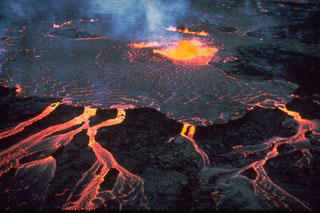Report on Kilauea (United States) — 9 March-15 March 2022
Smithsonian Institution / US Geological Survey
Weekly Volcanic Activity Report, 9 March-15 March 2022
Managing Editor: Sally Sennert.
Please cite this report as:
Global Volcanism Program, 2022. Report on Kilauea (United States) (Sennert, S, ed.). Weekly Volcanic Activity Report, 9 March-15 March 2022. Smithsonian Institution and US Geological Survey.
Kilauea
United States
19.421°N, 155.287°W; summit elev. 1222 m
All times are local (unless otherwise noted)
HVO reported that lava effusion from vents in the lower W wall of Kilauea’s Halema`uma`u Crater continued at variable rates during 8-15 March. Throughout February the main cone had broken down and by 4 March lava was effusing from multiple vents, including the tallest cone (19 m high); by 11 March lava was supplied from an embayment just N of the cone which had grown to 27 m high. Lava continued to feed the western active lava lake. Lava breakouts along the SE, NE, and NW lake margins were visible on a few of the days. Minor and slow crustal overturning occurred on the NW and SE parts of the lake’s margins during 13-14 March. The Aviation Color Code and the Volcano Alert Level remained at Orange and Watch, respectively.
Geological Summary. Kilauea overlaps the E flank of the massive Mauna Loa shield volcano in the island of Hawaii. Eruptions are prominent in Polynesian legends; written documentation since 1820 records frequent summit and flank lava flow eruptions interspersed with periods of long-term lava lake activity at Halemaumau crater in the summit caldera until 1924. The 3 x 5 km caldera was formed in several stages about 1,500 years ago and during the 18th century; eruptions have also originated from the lengthy East and Southwest rift zones, which extend to the ocean in both directions. About 90% of the surface of the basaltic shield volcano is formed of lava flows less than about 1,100 years old; 70% of the surface is younger than 600 years. The long-term eruption from the East rift zone between 1983 and 2018 produced lava flows covering more than 100 km2, destroyed hundreds of houses, and added new coastline.
Source: US Geological Survey Hawaiian Volcano Observatory (HVO)

